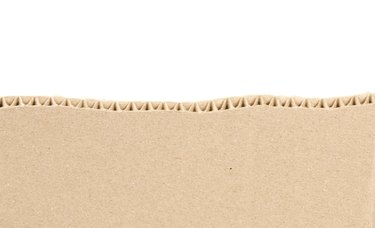
Whether you've made your own life-size cardboard cutout or acquired a premade version, it's not going to stand up on its own. Make your own stand for your cardboard figure out of scrap wood, or use cardboard for a portable option that disassembles with ease.
Weighty Wood
Video of the Day
Wood provides a stable support for a cardboard standee or cutout so you can even use the display outdoors during fairly calm days. A four-by-four provides ample height, width and weight to make a stand for securing even a tall cutout; if you can't find or cut wood in that size, cut two identical two-by-fours and glue them together with wood glue. Cut the wood so it's approximately 2 inches shorter than the width of the cutout's base. Place the clean wood on a level surface, and then stand the cutout in front of it so the wood touches the bottom back side of the cutout -- the wood should be centered behind the cutout. Staple the cutout to the wood every few inches near both the top and bottom of the board. Then carefully pick up the cutout while pressing the wood to it, moving it to the desired position. Enlist a friend's help for easier moving. If desired, add extra support for a tall cutout by gluing or stapling a thin strip of wood such as a tomato stake vertically to the center of the cutout's back. Add the extra support before attaching the base wood. For yet another option, cut an inch-deep, 1/4-inch-wide groove in the center of a wide board matching the cutout's width. Slide the cutout into this wood base.
Video of the Day
Vertical Cardboard Stand
Use cardboard for your cutout's stand -- it's a simple, customizable material that requires no sawing. Cut a piece of scrap corrugated cardboard into a tall, slightly curved shape similar to a bell cut in half vertically. The height of the new cardboard piece should be more than half the height of the cutout, and it should be at least 12 inches wide at its base. Line up a straightedge 2 inches from the straight vertical side of the cardboard, and then score the cardboard with a utility knife to make it easier to fold. Fold the narrow edge inward -- ultimately it should be able to stand at a 90-degree angle. Slice the flap 2 or 3 inches from the top, all the way to the fold line, to create another flap that folds in the opposite direction. Glue the flaps to the back of the cardboard -- one pointing to the right, one to the left, leaving the largest piece of cardboard perpendicular to the cutout. Use wood glue or school glue to secure the cardboard pieces together. Place weights such as heavy books on either side of the stand as the glue dries to ensure it dries at the right angle.
Removable Cardboard Base
Separate cardboard pieces that can be removed for storage provide a more portable base for your cutout. The downside is that the base is visible from the front. Cut a rectangular scrap of cardboard, such as a flap from a large box. The cardboard should be at least 24 inches long and 8 inches high, depending on the size of your cutout. Fold the cardboard in half so it is 12 inches long, or half its original length. Cut slits in the bottom of the cutout several inches from each side and 4 inches deep. Cut matching slits on the top of each half of the folded cardboard. Unfold the cardboard slightly and match the slits up on the stand and the cutout, on the back of the cutout. The fold of the cardboard points out, so together it forms a triangle with the cutout.
Magnet Magic
Glue strong disk magnets up the "spine" area of the cutout. Place a magnetic metal yardstick or shepherd's hook plant hanger into the ground so it stands freely, if you're using the cutout outdoors. Line the magnets up with the metal so the cardboard stands on its own. For an indoor version, place a low-profile filing cabinet or metal toolbox behind the cutout.